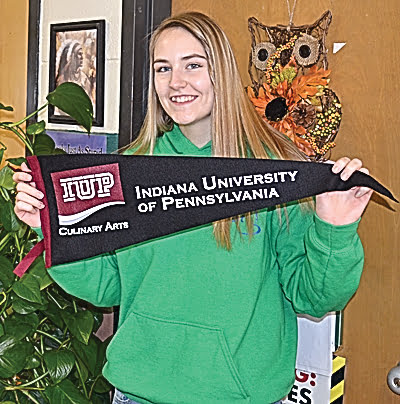
Suzanne Stewart
Staff Writer
Five teams of engineering students and STEM club members from Pocahontas County High School recently toted their pumpkin-saving apparatuses to West Virginia University to compete in the annual pumpkin drop at the Engineering school.
A total of 350 teams put their heads together to create a container to keep a pumpkin safe for the drop. Of those teams, only between 30 and 40 had successful pumpkin drops – a drop of 13 stories to the ground without breaking.
All five Pocahontas County teams were successful, with one placing second and another placing first. Unfortunately, the first place team’s pumpkin was too small, and they were disqualified.
The first place, but disqualified team members were Emmett Doolittle, Kylian Dennison and Charity Warder, who were understandably discouraged by the outcome, but still happy their pumpkin survived.
“It survived, so that was really cool,” Dennison said.
The team brainstormed a few weeks ahead of the competition and worked on their apparatus the week before the actual drop.
“Honestly, we were just trying to think of materials that are pliable and aren’t easily broken,” Dennison said. “We thought about bubble wrap. We had a rubber trashcan, instead of the hard plastic, and small balloons that were barely inflated so they were squishy.”
“Lots of padding,” Warder added. “Then we had a parachute so it wasn’t dropping too fast.”
Unlike most experiments, the team was unable to test its work because they had only one pumpkin, but they were still confident of their abilities.
“They have a target down at the bottom and whoever gets their pumpkin closest to the bulls-eye on the target gets more points,” Doolittle said. “We were almost spot on.”
“It was inches from the bulls-eye,” Dennison added.
“The people up at the top said we won, and then they pulled the pumpkin out and it fell through the measuring thing,” Doolittle said. “They told us we were disqualified.”
“It was a sad day,” Dennison said.
Despite the DQ, the team still had fun and cheered on their fellow classmates, including the team of Sierra Rodriguez, Dakin Rexode, Kiersten Taylor and Hazel Riley, who came home with second place.
The team took a different approach, using lots of soft materials to keep the pumpkin safe.
“The bottom layer was pillows and then the pumpkin was wrapped in bubble wrap and it sat on a [corrective cushion],” Rodriguez said. “Then we had memory foam pillows on top and on the sides of the pumpkin. Then, we just duct taped a lot.”
The second team also used a trashcan – complete with a parachute to help the pumpkin float safely to the bulls-eye.
Two members of the team were on the roof of the building with the other two on the ground, waiting for the outcome.
“I knew it was going to survive, but I did not think we were going to place,” Rodriguez said.
“It was like two feet, four inches [from the bulls-eye],” Taylor said. “The best was one foot, something.”
At one point in the competition, the team was first but was knocked down to third before finally finishing in second.
“We would have been in the top three regardless,” Rodriguez said.
While the pumpkin drop is a fun day for students to get together and try not to smash pumpkins, it’s also a time for them to learn – in a creative way – about engineering and math.
“We learned the force and how much velocity it’s going to have,” Taylor said. “That’s why we had the pillows in the bottom. It helped with the velocity.”
“And the impact,” Rexrode added. “That’s why we had the memory foam in the bottom.”
At the end of the day, the students were just pleased to have been part of the competition and to have a chance to visit WVU’s campus.
“It was definitely a good experience,” Rodriguez said.
Also participating on teams were: John Fitzgerald, Tucker McGee, Nathaniel Evans, and Samantha Hammons; Hadden Mick, Cheylin Woodruff, Logan Hively, Pyper Cowan, and Silas Riley; STEM club members Mason Solliday, Max O’Ganian, Jesse Bostic, Ty Cochran, and Carter Canada; and Chris Sutton’s Math 3 TR class.



